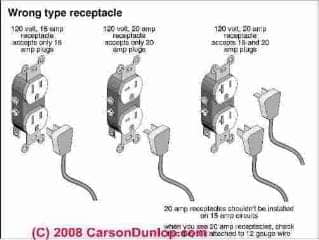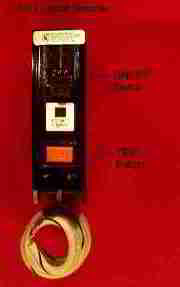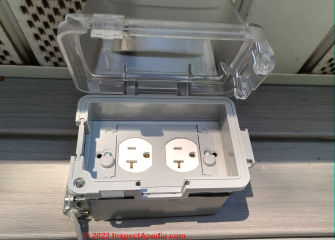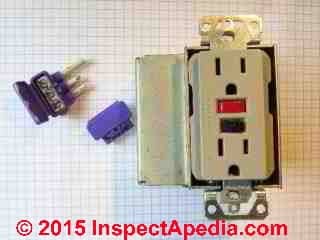 Electrical Receptacle Types
Electrical Receptacle Types
Buyer's Guide to electrical receptacles (wall plug or "outlet")
- POST a QUESTION or COMMENT about how to install and wire electrical outlets or receptacles in buildings.
Types of electrical receptacles: how to select the right type of electrical receptacle (outlet):
Here we illustrate and explain the uses of various types of electrical receptacles including 15-A vs 20-A rated devices, special receptacles for certain locations such as floor-mounted electrical receptacles and outdoor-use receptacles. We describe special electrical receptacles for use when no ground wire is present.
We also illustrate some antique electrical receptacles such as early round-pin Hubbel devices.
This article explains how to match the receptacle type to the circuit type and use. We describe both 120V receptacles and 240V receptacles. It's important to use 20-A rated receptacles if the electrical circuit is a 20-amp circuit. Don't install a grounded electrical receptacle plug on a circuit that has no electrical ground. Remember to install AFCI or GFCI devices where they are required.
This article series describes how to choose, locate, and wire an electrical receptacle in a home. Electrical receptacles (also called electrical outlets or "plugs" or "sockets") are simple devices that are easy to install, but there are details to get right if you want to be safe.
InspectAPedia tolerates no conflicts of interest. We have no relationship with advertisers, products, or services discussed at this website.
- Daniel Friedman, Publisher/Editor/Author - See WHO ARE WE?
Choose the Proper Electrical Receptacle Type

The proper type of electrical receptacle must be selected: some receptacles are rated only for 15-Amp circuits and must not be installed on a 20-Amp circuit.
20-Amp electrical receptacles may be designed to only accept plugs for 20-Amp appliances (which may have a different plug-spade configuration in which one of the plug terminals is twisted to be at 90 degrees to the other).
[Click to enlarge any image]
Some 20-Amp electrical receptacles are designed to accept either conventional plugs used by a 15-A appliance as well as 20-A plugs used by a 20-A appliance.
It's generally ok to plug a 15-A appliance into a 20-A circuit since that appliance is not going to overload the circuit in normal use. But the opposite is not true
. If you plug a 20-Amp appliance into a 15-Amp circuit you are risking overloading the circuit and tripping the circuit breaker, blowing the fuse, or worse, overheating the circuit and risking a fire.
Below our photographs illustrate a 15-Amp grounded electrical (below left) and a 20-Amp grounded electrical receptacle (below right).
You'll notice that the heavier-duty 20-Amp electrical receptacle has that T-slot at it's wider connection opening - an easy way to identify a wall receptacle rated for 20-Amps - provided that the receptacle was properly matched to the wire size and the circuit breaker or fuse size.
 ...
... 
Details about how to wire up an electrical receptacle are
at ELECTRICAL RECEPTACLE CONNECTION DETAILS - where to connect black, white, red, green, ground wires .
Two-Wire Electrical Receptacle Circuits

Older two-wire electrical circuits, such as the two circuits depicted at the right of our sketch above may provide only the hot and neutral wires and no ground wire.
Both of the receptacles shown above are referred to as "polarized receptacles" because there is one wider slot (neutral side or wire) and the other slot more narrow (the hot 120V wire). Typicalliy these receptacles were intended for use on a 15Amp circuit.
The left-hand receptacle is in the newer post -1960 style while the right hand receptacle, though you can still buy it new, was found principally in North American homes up to about 1960.
Watch out: If no ground wire or ground path is provided, it is improper and unsafe to install a grounding (3-prong) electrical receptacle on that circuit.
 Our photo (above left) shows a conventional grounded three-prong electrical receptacle - the round hole is the ground connection - at the left end of the picture closest to my thumb.
Our photo (above left) shows a conventional grounded three-prong electrical receptacle - the round hole is the ground connection - at the left end of the picture closest to my thumb.
At right in the photo is an ungrounded electrical receptacle. This is the right device to install if no ground is present on the electrical circuit.
You don't want to "fool" a building occupant into thinking that a ground is present when there is not one, so you don't install a receptacle that has that third ground opening in its face.
Some older two-wire circuits which are covered with a flexible metal jacket ("BX" or "armored cable" wire) may provide a ground path by means of the cable jacket itself.
We don't rely on it, and in event of certain short circuits it's unsafe: the exposed metal sheathing of the wire becomes live, risking a shock.
Details about how to wire up an un-grounded receptacle are
at 2-WIRE RECEPTACLE CONNECTIONS - no ground
The illustration at above-left shows the typical wiring of an electrical outlet or "receptacle", courtesy of Carson Dunlop Associates.
Click any image to see an enlarged, detailed view of electrical wiring details for "plugs" or electrical receptacles.
Choosing GFCI and AFCI Receptacles
Ground fault protection - GFCI's: The NEC also requires that only special ground fault circuit interrupter (GFCI) protected outlets can be installed in certain hazardous locations like kitchens, baths, garages, outdoors.
A GFCI-protected electrical receptacle includes circuitry that turns the electric power off at the outlet quickly should a ground-fault (electricity flowing to earth, such as through your hand and down a water pipe) be detected. [4]

Arc fault protection - AFCI's: Beginning in 2002 the NEC also required arc fault protection for electrical outlets for bedrooms. [4]
AFCI's are similar to GFCI's discussed above, but they include an additional level of protection against fire by detecting small electrical arcing at a connection - a condition that can lead to overheating and fire.
As you can see from this US CPSC photo, you can add Arc fault protection to a home circuit by installing a special circuit breaker in the electrical panel.
By this means you can provide arc fault protection and thus improved fire safety for all electrical outlets on the circuit - for example in the building's bedrooms
In the FAQs (below) we discuss the importance of wiring the Line and Load terminals of GFCIs and AFCIs correctly.
See AFCI GFCI WIRING, TESTING & SAFETY
and AFCIs ARC FAULT CIRCUIT INTERRUPTERS for details about these devices.
Readers of this article should also see SAFETY for ELECTRICAL INSPECTORS.
This website provides information about a variety of electrical hazards in buildings, with articles focused on the inspection, detection, and reporting of electrical hazards and on proper electrical repair methods for unsafe electrical conditions.
Back-Wired Electrical Receptacles
Question: Is it safe to plug a 10-Amp A/C into an outlet that is back wired?
Is it safe to plug in an ac unit that runs 10 amps , into outlet that is backed wired, i had read that you don't like this method, the outlet is on third floor and is on a 15 amp breaker - Johnny B 5/2/12
Reply: Comparing Three Types of Backwired Receptacles: 20-A Clamp Type & 15-ASpring Type & Clamp Type Backwiring Devices
 Johnny, that's an interesting question and one I'm scared to answer - by online posting one cannot assure the electrical safety of your building.
Johnny, that's an interesting question and one I'm scared to answer - by online posting one cannot assure the electrical safety of your building.
Details about back-wired electrical devices (receptacles & switches) are
at BACK-WIRED ELECTRICAL DEVICES.
Here we will illustrate three different types of electrical receptacles that can be wired from their back-side.
Our photo (left) illustrates a spec-grade 20-Amp, 125V rated electrical receptacle that looks as if it is "back-wired" - in fact while a wire can be wrapped around the terminal screws on this device.
The screw is intended to be used to tighten a rectangular brass plate against a square metal nut (silver in color) that makes a very strong and positive connection over a good area of wire surface.
This receptacle is marked on its back surface as CU Wire Only - copper only. [Click images to see enlarged details.]
That said, I agree that older, spring-type back-wired electrical connections (shown at below left) are not as reliable as connections made under a screw or clamp, as the total contact area between the back-wire spring edge and the wire surface is minimal.
Nevertheless, on a 15-A circuit using 15-A devices such as receptacles, the circuit and its devices are rated and intended to be able to support the 10-amp load you describe, so long as the sum of all of the items plugged into that electrical circuit don't overload it.
Contractor-grade 15-A spring-type-connector back-wired electrical receptacles (below left) provide a single opening at each of the four terminals (two neutral wires, two hot wires) on the back of the receptacle (red arrow).
The yellow arrow points to a release spring that will allow removal of the wire, but we prefer not to re-use this type of back-wired receptacle. Tightening the screw at the main wire terminal (blue arrow) has nothing to do with the spring-clamp that is securing the back-wired terminal wire.
 ...
... 
Some newer heavy-duty 15-A back-wired electrical receptacles (above right) o not rely on a simple spring-edge to contact the electrical wire, as we illustrate in our second photo (above right).
Rather, when the wire is inserted into a receiving hole on the back of the receptacle (either of the two red arrows).
When the terminal screw is tightened (blue arrow) that actually snugs up a clamp that contacts a much larger surface area of the back-wired wire.
That's a more secure connection mechanically. On this receptacle, instead on a single back terminal accepting a single wire, there are a pair of back terminal openings at each of the four terminal screws.
Follow-up:
Thank you for responding, my town home was built in 1999, not sure if that is considered newer or older, lights do dim though when i use 10 amp vacuum . - Johnny B.
Reply:
Backwiring electrical receptacles is a permitted installation and might be found in a 1999 home - but as we show above, there are two different approaches, the second of which is a better quality installation and is in our opinion more reliable.
Floor-Mounted Electrical Receptacles
Above: we illustrate a common use of a floor-mounted electrical receptacle, in this case in the second floor waiting area of the Duluth International Airport, Duluth Minnesota. DLH. Our second photo above illustrates older floor-located electrical "outlets" (properly called receptacles) mounted in the flooring at Mohonk Mountain House, shown in more detail below on this page.
Where installed indoors, a floor-mounted electrical receptacle doesn't need to be waterproof (though many models are sold as "weather resistant" and can tolerate damp mopping of the floor surface. A floor-mounted receptacle does need to be installed with a proper cover to avoid damage. (An example form Enerlites is shown below).
Above, as described by electricalmarketplace.com, the ENERLITES 975506-C/SS is a 1-gang brass floor box assembly with a tamper-weather-resistant duplex receptacle. The device features 20A tamper-resistant duplex receptacles, which include internal shutters to prevent the insertion of foreign objects. The floor box lays flush and opens easily with coin-lifted screw plugs.
Floor-installation electrical receptacles may be flush-mounted, or even slightly in-set into the floor surface so that the receptacle cover comes flush with the surrounding floor surface, or floor receptacles may be slightly raised, like the round Walker 861QTCGY wood/raised quad floor box shown just below.
In our OPINON in addition to the requirement that a floor-mounted electrical receptacle has to be able to withstand normal foot traffic or movement of typical equipment across a residential floor (vacuum cleaners, for example), and while it's good design to be moisture resistant, a floor-mounted electrical "outlet" should include not just secure receptacle opening covers (screw type in our example but hinged versions are available too), it should also include shutter-type electrical receptacles themselves so as to resist dirt or objects that might otherwise fall into and foul the receptacle slots.
In proper condition an in-floor electrical receptacle cover will be secure (no loose parts), complete, (no missing receptacle opening covers), and, of course properly-wired.
The old but in-good-condition round brass covered floor receptacle set shown just below is installed in a hotel in Niagara Falls, New York.
Floor-Mounted Electrical Receptacle Safety Defects
In contrast, in our first photo below, the electrical outlet in a New York City hotel floor shown below is missing two of its receptacle opening covers and could be damaged, dirt-contaminated, and unsafe, while our second photo of a still older duplex floor receptacle that has no protective covers over its electrical receptacle openings is installed in the wood flooring of the Mohonk Mountain House, near New Paltz, New York.
Antique Floor Electrical Receptacles
Photo below: a round pin electrical receptacle, possibly with ground and missing one mounting screw, possibly an early Hubbell-design round two-pin floor receptacle, courtesy of Bay State Home Inspections. This round-pin receptacle is not polarized, widely found in North American homes up to about 1930 and is described in detail below in our section on electrical outlet patents.
Outdoor Electrical Receptacles (Outlets)
Shown above, a weatherproof electrical box and receptacle mounted on a home in northern Minnesota.
This electrical receptacle is located quite high on an exterior wall, just under the soffit overhang where it will be used to power a security camera. Both a weather-proof electrical box and a GFCI-protected electrical receptacle or (in this case) a GFCI-protected elecctrical circuit are required by electrical codes.
GFCI Electrical Receptacles
Below is an indoor GFCI electrical receptacle and in our second photo a detail showing how the electrical box was extended to provide more wiring space so that aluminum electrical wiring repair splice devices could be used.
Details are at GFCI PROTECTION, GFCI CODES
Older & Antique Electrical Receptacles or "Outlets"
This discussion has moved
to ANTIQUE & OLD ELECTRICAL RECEPTACLES
240VAC Electrical Receptacles
 There are several common appliances or tools that require a 240-Volt-AC electrical receptacle and a number of 240VAC (or 220 VAC or 204VAC depending on where you live) electrical receptacle designs.
There are several common appliances or tools that require a 240-Volt-AC electrical receptacle and a number of 240VAC (or 220 VAC or 204VAC depending on where you live) electrical receptacle designs.
When wiring a 240V receptacle the circuit wires used will include
- A black "hot" wire (120V)
- A red "hot" wire (120V) normally from separate circuit that is on the opposite side or different elecrical phase in the electrical panel from the black wire
- A grounding conductor wire
No neutral wire is typically connected to this device. The 240V power is achieved across the two individual 120V "hot" circuits.
Examples are listed below.
Our photo of a 240V electrical receptacle shown here is a 20-Amp 240-volt electrical outlet that would be installed on a 20-Amp wall or window air conditioner circuit in a building.
This particular recetpacle, a Leviton product, is UL-listed for 20 Amp, 250 Volt, NEMA 6-20R, 2-pole, 3-wire circutis; it's further described as a narrow-body single receptacle, straight blade, commercial grade, grounding, side-wired, steel strap; available in ivory, white, brown. Similar products are sold in North America by Cooper, Eagle Wiring, and Pass & Seymour.
240-Volt window or through-wall room air conditioner
240-Volt equipment such as small welders
Below are two additional configurations and types of 240 VAC electrical receptacles.
The white three-bladed 240-V receptacle below is a 20-Amp Leviton product that is a non-grounding type electrical receptacle. This is a 20A, 125/250 V, NEMA 10-20R, 2P, 3W, narrow-body single receptacle, straight bladeed, non-grounding, side-wired, steel strap device.
The orange 240 V receptacle below is a also a Leviton product, a flush-mounting twistlock single 20-Amp receptacle wired to provide an isolated ground and is described as a 20-A, 250V, NEMA L6-20R, 2P, 3W, flush mount locking receptacle, industrial grade with locking ground.
...
Reader Comments, Questions & Answers About The Article Above
Below you will find questions and answers previously posted on this page at its page bottom reader comment box.
Reader Q&A - also see RECOMMENDED ARTICLES & FAQs
On 2020-07-17 - by (mod) -
CW
Thank you for an important technical point. We are in complete agreement.
On 2020-07-16 by CW
According to the US National Electric Code, 15A receptacles can be accomodated on a 20A circuit. This is because the load of the circuit is distributed across multiple point in the circuit. Most electrical devices are rated for a load larger than its standard operating load so this can be safely done.
I am not encouraging the use of electrical equipment beyond it standardized intended range. Just as 14AWG wire is actually rated for 20A but is downgraded to 15A, Just as 12AWG is rated for 30A but is downgraded for use at 20A.
On 2017-12-16 - by (mod) -
Kahn
What is the question?
On 2017-12-16 by Khan
Adding a lighted mirror to a Ground Fault Reciptcle
On 2016-04-14 - by Denny
Denny said:
As you know, the power strips and surge protectors are extremelynecessary for everyone’s everyday life! In our home or office, we have lots of electronic devices, like smartphones, ipads, TVs, computers, laptops, etc;
They are running Simultaneously for a long time during each day, so that frankly speaking, having a safety, stable and robust power strip is very very important for us! With the help of the safety surge protector, it not only provides robust electric current output, but also make sure to protect your electronic devices from serious frying.
...
Continue reading at BACK-WIRED ELECTRICAL DEVICES or select a topic from the closely-related articles below, or see the complete ARTICLE INDEX.
Or see these
Recomended Articles
- 2-WIRE RECEPTACLE CONNECTIONS - no ground
- ANTIQUE & OLD ELECTRICAL RECEPTACLES
- ELECTRICAL BOX TYPES
- ELECTRICAL GROUNDING in OLDER HOMES
- ELECTRICAL JUNCTION BOX TYPES
- ELECTRICAL RECEPTACLE CONNECTION DETAILS - where to connect black, white, red, green, ground wires
- ELECTRICAL RECEPTACLE HEIGHT & CLEARANCE
- ELECTRICAL RECEPTACLE LOCATIONS
- GFCI PROTECTION, GFCI CODES - ground-fault-circuit-interruptor receptacles (and circuit breakers)
- HOW TO ADD an ELECTRICAL OUTLET - home
- OLD ELECTRICAL BOX TYPES
Suggested citation for this web page
ELECTRICAL RECEPTACLE TYPES at InspectApedia.com - online encyclopedia of building & environmental inspection, testing, diagnosis, repair, & problem prevention advice.
Or see this
INDEX to RELATED ARTICLES: ARTICLE INDEX to ELECTRICAL INSPECTION & TESTING
Or use the SEARCH BOX found below to Ask a Question or Search InspectApedia
Ask a Question or Search InspectApedia
Try the search box just below, or if you prefer, post a question or comment in the Comments box below and we will respond promptly.
Search the InspectApedia website
Note: appearance of your Comment below may be delayed: if your comment contains an image, photograph, web link, or text that looks to the software as if it might be a web link, your posting will appear after it has been approved by a moderator. Apologies for the delay.
Only one image can be added per comment but you can post as many comments, and therefore images, as you like.
You will not receive a notification when a response to your question has been posted.
Please bookmark this page to make it easy for you to check back for our response.
IF above you see "Comment Form is loading comments..." then COMMENT BOX - countable.ca / bawkbox.com IS NOT WORKING.
In any case you are welcome to send an email directly to us at InspectApedia.com at editor@inspectApedia.com
We'll reply to you directly. Please help us help you by noting, in your email, the URL of the InspectApedia page where you wanted to comment.
Citations & References
In addition to any citations in the article above, a full list is available on request.
- [1] ...
- Timothy Hemm has provided photographs of various electrical defects used at the InspectAPedia TM Website. Mr. Hemm is a professional electrical inspector in Yucala, CA.
- Mark Cramer Inspection Services Mark Cramer, Tampa Florida, Mr. Cramer is a past president of ASHI, the American Society of Home Inspectors and is a Florida home inspector and home inspection educator. Mr. Cramer serves on the ASHI Home Inspection Standards. Contact Mark Cramer at: 727-595-4211 mark@BestTampaInspector.com
- John Cranor [Website: /www.house-whisperer.com ] is an ASHI member and a home inspector (The House Whisperer) is located in Glen Allen, VA 23060. He is also a contributor to InspectApedia.com in several technical areas such as plumbing and appliances (dryer vents). Contact Mr. Cranor at 804-873-8534 or by Email: johncranor@verizon.net
- [3] NFPA - the National Fire Protection Association can be found online at www.nfpa.org
- [4] The 2008 NEC National Electrical Code (ISBN 978-0877657903) Online Access LINK (you'll need to sign in as a professional or as a visitor)
http://www.nfpa.org/catalog/services/Login/prelogin.asp?npg=http%3A//www.nfpa.org/freecodes/free_access_agreement.asp?id=7008SB - [5] Special thanks to our reader Steve who pointed out prior errors in our illustrations.
- [5] Special thanks to our reader Steve who pointed out prior errors in our illustrations.
- [6] Simpson Strong-Tie, "Code Compliant Repair and Protection Guide for the Installation of Utilities in Wood Frame Construction", web search 5/21/12, original source strongtie.com/ftp/fliers/F-REPRPROTECT09.pdf, [copy on file as /Structures/Framing/Simpson_Framing_Protectors.pdf ]. "The information in this guide is a summary of requirements from the 2003, 2006 and 2009 International Residential Code (IRC), International Building Code (IBC), International Plumbing Code (IPC), International Mechanical Code (IMC), 2006 Uniform Plumbing Code (UPC) and the 2005 National Electrical Code."
- "Electrical System Inspection Basics," Richard C. Wolcott, ASHI 8th Annual Education Conference, Boston 1985.
- "Simplified Electrical Wiring," Sears, Roebuck and Co., 15705 (F5428) Rev. 4-77 1977 [Lots of sketches of older-type service panels.]
- "How to plan and install electric wiring for homes, farms, garages, shops," Montgomery Ward Co., 83-850.
- "Simplified Electrical Wiring," Sears, Roebuck and Co., 15705 (F5428) Rev. 4-77 1977 [Lots of sketches of older-type service panels.]
- "Home Wiring Inspection," Roswell W. Ard, Rodale's New Shelter, July/August, 1985 p. 35-40.
- "Evaluating Wiring in Older Minnesota Homes," Agricultural Extension Service, University of Minnesota, St. Paul, Minnesota 55108.
- "Electrical Systems," A Training Manual for Home Inspectors, Alfred L. Alk, American Society of Home Inspectors (ASHI), 1987, available from ASHI. [DF NOTE: I do NOT recommend this obsolete publication, though it was cited in the original Journal article as it contains unsafe inaccuracies]
- "Basic Housing Inspection," US DHEW, S352.75 U48, p.144, out of print, but is available in most state libraries.
- In addition to citations & references found in this article, see the research citations given at the end of the related articles found at our suggested
CONTINUE READING or RECOMMENDED ARTICLES.
- Carson, Dunlop & Associates Ltd., 120 Carlton Street Suite 407, Toronto ON M5A 4K2. Tel: (416) 964-9415 1-800-268-7070 Email: info@carsondunlop.com. Alan Carson is a past president of ASHI, the American Society of Home Inspectors.
Thanks to Alan Carson and Bob Dunlop, for permission for InspectAPedia to use text excerpts from The HOME REFERENCE BOOK - the Encyclopedia of Homes and to use illustrations from The ILLUSTRATED HOME .
Carson Dunlop Associates provides extensive home inspection education and report writing material. In gratitude we provide links to tsome Carson Dunlop Associates products and services.















